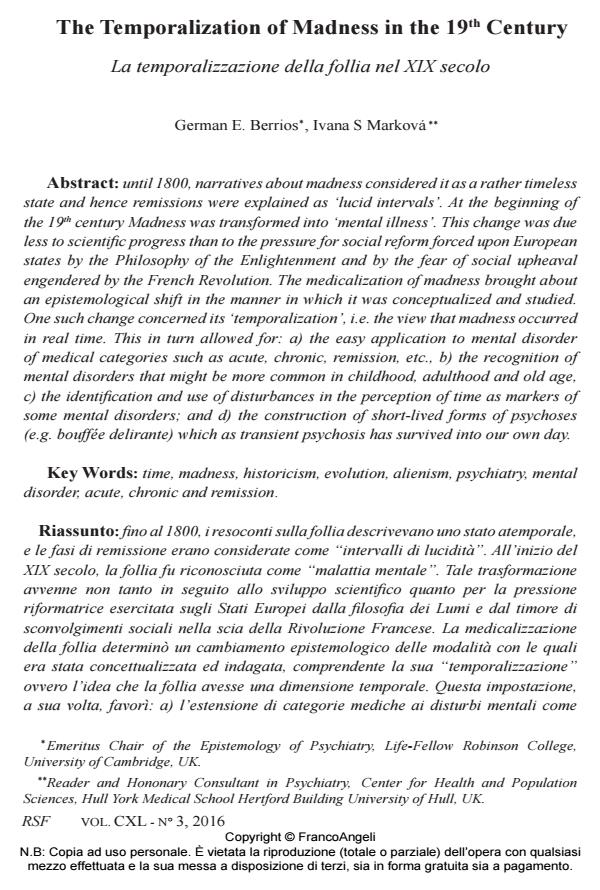The Temporalization of Madness in the 19th Century.
Titolo Rivista RIVISTA SPERIMENTALE DI FRENIATRIA
Autori/Curatori German E. Berrios, Ivana S Markovà
Anno di pubblicazione 2016 Fascicolo 2016/3
Lingua Inglese Numero pagine 15 P. 13-27 Dimensione file 640 KB
DOI 10.3280/RSF2016-003002
Il DOI è il codice a barre della proprietà intellettuale: per saperne di più
clicca qui
Qui sotto puoi vedere in anteprima la prima pagina di questo articolo.
Se questo articolo ti interessa, lo puoi acquistare (e scaricare in formato pdf) seguendo le facili indicazioni per acquistare il download credit. Acquista Download Credits per scaricare questo Articolo in formato PDF

FrancoAngeli è membro della Publishers International Linking Association, Inc (PILA)associazione indipendente e non profit per facilitare (attraverso i servizi tecnologici implementati da CrossRef.org) l’accesso degli studiosi ai contenuti digitali nelle pubblicazioni professionali e scientifiche
Until 1800, narratives about madness considered it as a rather timeless state and hence remissions were explained as ‘lucid intervals’. At the beginning of the 19th century Madness was transformed into ‘mental illness’. This change was due less to scientific progress than to the pressure for social reform forced upon European states by the Philosophy of the Enlightenment and by the fear of social upheaval engendered by the French Revolution. The medicalization of madness brought about an epistemological shift in the manner in which it was conceptualized and studied. One such change concerned its ‘temporalization’, i.e. the view that madness occurred in real time. This in turn allowed for: a) the easy application to mental disorder of medical categories such as acute, chronic, remission, etc., b) the recognition of mental disorders that might be more common in childhood, adulthood and old age, c) the identification and use of disturbances in the perception of time as markers of some mental disorders; and d) the construction of short-lived forms of psychoses (e.g. bouffée delirante) which as transient psychosis has survived into our own day.
Fino al 1800, i resoconti sulla follia descrivevano uno stato atemporale, e le fasi di remissione erano considerate come "intervalli di lucidità". All’inizio del XIX secolo, la follia fu riconosciuta come "malattia mentale". Tale trasformazione avvenne non tanto in seguito allo sviluppo scientifico quanto per la pressione riformatrice esercitata sugli Stati Europei dalla filosofia dei Lumi e dal timore di sconvolgimenti sociali nella scia della Rivoluzione Francese. La medicalizzazione della follia determinò un cambiamento epistemologico delle modalità con le quali era stata concettualizzata ed indagata, comprendente la sua "temporalizzazione" ovvero l’idea che la follia avesse una dimensione temporale. Questa impostazione, a sua volta, favorì: a) l’estensione di categorie mediche ai disturbi mentali come ad es. stato acuto, cronico, remissione, ecc.; b) il riscontro di malattie mentali la cui frequenza verosimilmente varia secondo le fasi della vita; c) l’individuazione di anomalie della percezione del tempo utilizzate alla stregua di markers di alcuni disturbi mentali; e d) la descrizione di sindromi psicotiche di breve durata (es. bouffée délirante) che sono giunte fino a nostri giorni come ad es. la psicosi transitoria.
Parole chiave:Tempo, follia, storicismo, evoluzione, alienismo, psichiatria
- Values in Psychiatry German E. Berrios, Ivana S. Marková, pp.5 (ISBN:9781108883535)
German E. Berrios, Ivana S Markovà, The Temporalization of Madness in the 19th Century. in "RIVISTA SPERIMENTALE DI FRENIATRIA" 3/2016, pp 13-27, DOI: 10.3280/RSF2016-003002